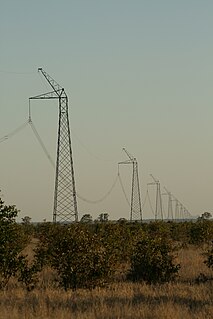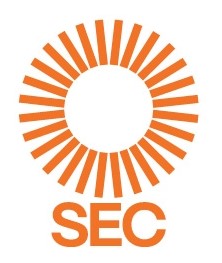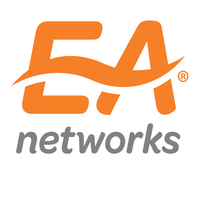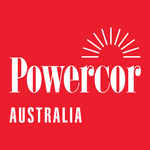
Electric power distribution is the final stage in the delivery of electric power; it carries electricity from the transmission system to individual consumers. Distribution substations connect to the transmission system and lower the transmission voltage to medium voltage ranging between 2 kV and 35 kV with the use of transformers. Primary distribution lines carry this medium voltage power to distribution transformers located near the customer's premises. Distribution transformers again lower the voltage to the utilization voltage used by lighting, industrial equipment and household appliances. Often several customers are supplied from one transformer through secondary distribution lines. Commercial and residential customers are connected to the secondary distribution lines through service drops. Customers demanding a much larger amount of power may be connected directly to the primary distribution level or the subtransmission level.

A substation is a part of an electrical generation, transmission, and distribution system. Substations transform voltage from high to low, or the reverse, or perform any of several other important functions. Between the generating station and consumer, electric power may flow through several substations at different voltage levels. A substation may include transformers to change voltage levels between high transmission voltages and lower distribution voltages, or at the interconnection of two different transmission voltages.

Single-wire earth return (SWER) or single-wire ground return is a single-wire transmission line which supplies single-phase electric power from an electrical grid to remote areas at low cost. Its distinguishing feature is that the earth is used as the return path for the current, to avoid the need for a second wire to act as a return path.

A utility pole is a column or post used to support overhead power lines and various other public utilities, such as electrical cable, fiber optic cable, and related equipment such as transformers and street lights. It can be referred to as a transmission pole, telephone pole, telecommunication pole, power pole, hydro pole, telegraph pole, or telegraph post, depending on its application. A Stobie pole is a multi-purpose pole made of two steel joists held apart by a slab of concrete in the middle, generally found in South Australia.

Vector Limited is an electricity and gas distribution company in Auckland, New Zealand. It is the national number one provider of electricity distribution, number one provider of electricity and gas metering and number two wholesaler of LPG. It also owns a fibre optic cable network.

The State Electricity Commission of Victoria is a government-owned electricity supplier in Victoria, Australia. It was set up in 1918, and by 1972 it was the sole agency in the state for electricity generation, transmission, distribution and supply. Control of the SECV was by a Board of Commissioners appointed by the Victorian Government. After 1993, the SECV was disaggregated into generation, transmission and distribution companies, which were further split and then privatised in the mid to late 1990s. However, electricity supply agreements with the Portland and Point Henry aluminium smelters were retained by SECV, which continued as their electricity supplier.

Integral Energy was the second largest state-owned energy corporation in New South Wales, incorporated under the Energy Services Corporations Act 1995 from a merger between Prospect Electricity and Illawarra Electricity. Integral Energy was involved in electricity retail in addition to owning an electricity distribution network and previously held licences to retail electricity in the contestable markets covered by the NEM.
Western Power is a statutory corporation established by the Electricity Corporations Act 2005 (WA). It is owned by the State Government of Western Australia and is accountable to the Minister for Energy. It is responsible for building, maintaining and operating the electricity network within the South West Interconnected System (SWIS), the poles and wires or energy grid.

SP Group is a government-owned electricity and gas distribution company in Singapore. Singapore Power Group is the corporatised entity of the former electricity and gas departments of the Public Utilities Board. SP Group was first incorporated as a commercial entity on 1 October 1995 as Singapore Power and Gas to take over the electricity and gas businesses of the state provider, the Public Utilities Board.
Transgrid is the manager and operator of the high voltage electricity transmission network in New South Wales and the Australian Capital Territory, Australia, and is part of the National Electricity Market (NEM). The company's offices are located in Sydney, Newcastle, Orange, Tamworth, Wagga, and Yass.
The electricity sector in New Zealand uses mainly renewable energy; such as hydropower, geothermal power and increasingly wind energy. As of 2019, 82% of electricity is generated from renewable sources, making New Zealand one of the countries with the lowest carbon dioxide emissions from electricity generation. Electricity demand grew by an average of 2.1% per year from 1974 to 2010 but decreased by 1.2% from 2010 to 2013.

An electrical grid is an interconnected network for electricity delivery from producers to consumers. Electrical grids vary in size and can cover whole countries or continents. It consists of:

Orion New Zealand Limited (Orion) is an electricity distribution company, based in Christchurch, New Zealand.
Vermont electric power needs are served by over twenty utilities. The largest is Green Mountain Power, a subsidiary of Énergir which recently also took over Central Vermont Public Service. Together this single company represents 70% of the retail customers in Vermont. The state is a small electricity consumer compared with other states. Therefore, its electricity sector has the lowest carbon footprint in the country. As of 2010, the state had the lowest wholesale electricity costs in New England. Efficiency Vermont engages in aggressive initiatives to cut residential electricity waste, which often identifies other problems that it claims can save hundreds per household per year. Accordingly, Vermont's overall energy bills are also relatively lower than in the rest of the New England states.

The provision of electricity in Queensland required a considerable degree of pioneering, innovation, and commitment. Queensland proved to be a pioneer in the supply of electricity in Australia, with the first public demonstration in Australia, the first recorded use for public purposes in the country, the first Parliament House in Australia and the first commercial operations in Australia all occurring in Brisbane.

Electricity Ashburton Limited, trading as EA Networks is a co-operatively-owned electricity distribution company, based in Ashburton, New Zealand.

Multinet Gas is an Australian energy company and one of three Victorian natural gas distribution networks.

Dhaka Electric Supply Company Limited, commonly known as DESCO, is a public limited company which distributes electricity at the Northern parts of Dhaka City and Tongi Town of Gazipur District. The company was created in November 1996 under the Companies Act 1994 as a Public Limited Company. The company is now under the Power Division of the Bangladesh Ministry of Power, Energy and Mineral Resources and serving a total number of 604,304 consumers as of 31 December 2013. Md. Selim Uddin, rank of additional secretary, is the chairperson of DESCO and Engr. Md. Kausar Ameer Ali is the managing director.
United Energy is a Victorian energy network which distributes electricity across east and south-east Melbourne and the Mornington Peninsula to more than 640,000 customers, 90% of which are residential. Its network includes 209,000 poles and over 13,000 kilometres of wires. Electricity is received via 78 sub-transmission lines at 46 zone stations, where it is transformed from sub-transmission voltages to distribution voltages.

Electricity Substation No. 269 is a heritage-listed electrical substation located at 36 Anglesea Street, Bondi, Waverley Municipality, New South Wales, Australia. It was designed by Walter Frederick White, City Architect's Office and Municipal Council of Sydney and built in 1928 by the Municipal Council of Sydney. It is also known as #269 'WAVERLEY' 33KV ZONE, ELECTRICITY DEPT SUBSTATION No. 269, Angelsea Sub Station and Waverley Zone Substation. The property is owned by Ausgrid, an agency of the Government of New South Wales. It was added to the New South Wales State Heritage Register on 2 May 2008.















